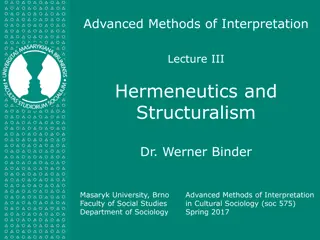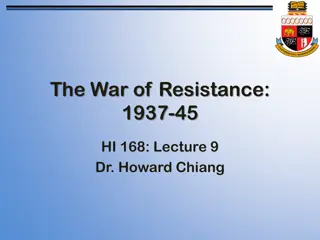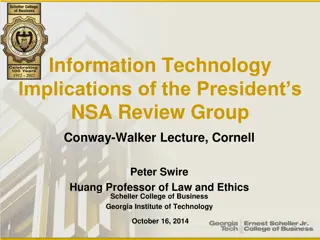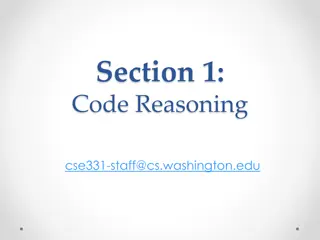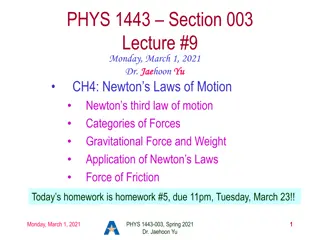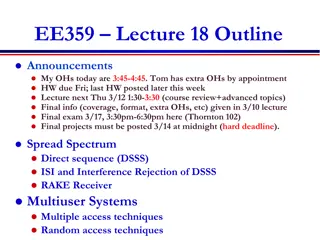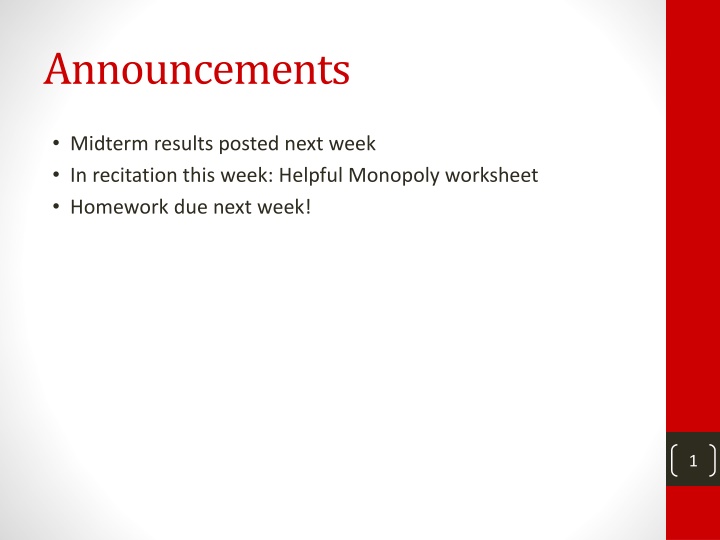
Understanding Monopoly in Economics
Explore the concepts of natural monopoly, perfect price discrimination, and examples of monopolies in various industries. Learn how a monopolist's pricing strategy can impact market dynamics and efficiency. Discover the implications of perfect price discrimination on surplus optimization and compare it to perfect competition scenarios.
Download Presentation

Please find below an Image/Link to download the presentation.
The content on the website is provided AS IS for your information and personal use only. It may not be sold, licensed, or shared on other websites without obtaining consent from the author. If you encounter any issues during the download, it is possible that the publisher has removed the file from their server.
You are allowed to download the files provided on this website for personal or commercial use, subject to the condition that they are used lawfully. All files are the property of their respective owners.
The content on the website is provided AS IS for your information and personal use only. It may not be sold, licensed, or shared on other websites without obtaining consent from the author.
E N D
Presentation Transcript
Announcements Midterm results posted next week In recitation this week: Helpful Monopoly worksheet Homework due next week! 1
Order of business Natural Monopolies Perfect price discrimination Imperfect price discrimination 2
Natural Monopoly If economies of scale are important, there may only be room for one firm. Go back to S4 widget monopoly and assume suppose a fixed cost of $6. Even if there is free entry and lots of people just like S4, only one will enter. Remember without the fixed cost monopoly profit is $9. With fixed cost, a monopolist earns $3 = $9 - $6. If two firms enter, even if they act like monopoly, the $9 can t cover paying fixed cost twice. 3
10 9 8 7 6 ATC 5 MC 4 3 D 2 MR 1 0 -1 0 1 2 3 4 5 6 7 8 9 10 -2 Discuss: add fixed cost, price stays the same. Why? 4
Can use the table to see this. Q P Rev FC = 0 FC = 6 Cost 4 8 12 16 20 Profit 5 8 9 8 5 Cost Profit 1 2 3 4 5 9 8 7 6 5 9 16 21 24 25 What would cause the price that a monopolist charge to change? 5
Examples of Natural Monopoly Distribution of residential electric power. Water Gas station in very small town. Above is all cost-side driven. What about demand-side? Network benefits for users potentially creates a natural monopoly. Facebook? 6
Perfect Price Discrimination Uniform pricing: all pay the same price per unit. Perfect Price Discrimination: monopolist charges everyone their reservation price. In Econland, D1 would pay 9 D2 would pay 8, etc. Now marginal revenue is the price paid (since keep the price high on the first units). 7
Graphically: 10 9 8 7 6 MC=ATC 5 4 3 D 2 1 0 0 1 2 3 4 5 6 7 8 9 10 Extracts all surplus! 8
What about efficiency with perfect price discrimination? Since monopolist gets all the surplus, it maximizes the surplus! What is the difference when there is a monopolist who can perfectly price discriminate and when we have perfect competition? 10 9 8 7 6 MC=ATC 5 4 3 9 D 2 1 0 0 1 2 3 4 5 6 7 8 9 10
Imperfect Price Discrimination This is a more likely case With uniform pricing, S4 sets P = 7 Q = 3 (sells to D1, D2, D3) One day S4 notices: D1, D2, D3 all happen to be 30 years old D4, D5, D6, all senior citizens. Brilliant idea! Senior citizen discount How does it work? Set P = $7 as regular price. Sell Q = 3 at regular price. 10
To get demand in senior market, chop off first three units of the demand curve (these are the 30 year olds) $ 10 $ 9 8 8 7 7 6 6 MC=ATC 5 5 4 4 3 3 DYoung 2 2 D DOld 1 1 0 0 0 1 2 3 4 5 6 7 8 9 10 0 1 2 3 4 5 6 7 Q Demand from Seniors Demand from Young Q 11
$ 8 7 What is profit off seniors? 6 5 First: What do we need? 4 3 2 DOld 1 0 0 1 2 3 4 5 6 7 Q Demand from Seniors 12
In the senior market, MC=MR when quantity is 1.5 Price to seniors: $5.50 Profit on seniors: = (P ATC)*Q = (5.5 4)*1.5 = 2.25 Profit in regular market (selling to the young) = $9 (just like before) Total profit (adding profit on seniors) is 9 + 2.25 = 11.25 13
10 Graphically: 9 8 7 6 MC=ATC 5 4 3 D 2 1 0 0 1 2 3 4 5 6 7 8 9 10 14
Who wins, who loses when firm can price discriminate? 1. Firm wins. 2. Seniors win. 3. Here 30 year olds don t care. Pay $7 either way. But can change the numbers so they pay more (i.e. what if only D1 and D2 are 30 year olds?) So possible they are worse off. 15 But is it possible that they are better off?
The people paying high price can benefit from price discrimination if the product would not exist otherwise. Suppose there is a fixed cost of $10. Uniform pricing: Profit after fixed cost = -$1 There is a loss, so the firm will exit (and not produce anything) Profit is $9 with no fixed cost Subtract the fixed cost of $10 Price Discrimination Profit is $11.25 with no fixed cost Subtract the fixed cost of $10 Profit after fixed cost = $1.25 There is profit, so the firm will stay in and produce 16
A major issue that firms practicing price discrimination need to deal with is how to keep the markets separate. People paying the high price will try to figure out how to pay the low price. Example: Americans buying drugs in Canada. How do airlines do it? 17
Ability to practice price discrimination can make the allocation more efficient: Expansion of output in markets where marginal benefit > marginal cost Can possibly even benefit people who pay the high prices if the product would not exist without price discrimination (because the firm might otherwise not be able to capture enough revenue to pay fixed cost). But . 18
Can lead to inefficiencies as firms add restrictions to keep markets separate. For example, airlines sometimes require a Saturday stayover to get a cheap fare. Of course a traveler staying over a Saturday does nothing to reduce the cost to the airline of serving the customer. What this restriction can do is help separate the business travel market from the personal travel market. 19
One more example: Coupons Suppose monopolist in EconLand wants to make more profit than the uniform-price monopolist profit Faced with MC=ATC=4 20
10 9 8 7 6 5 4 3 2 D 1 0 -1 0 1 2 3 4 5 6 7 8 9 10 11 12 13 14 15 16 -2 -3 21 Uniform price monopolist profit=
10 9 8 7 6 Profit from non- coupon users 5 MC=ATC 4 3 2 D 1 0 -1 0 1 2 3 4 5 6 7 8 9 10 11 12 13 14 15 16 -2 MR -3 22
10 9 8 7 6 Profit from non- coupon users 5 MC=ATC 4 3 2 D 1 0 -1 0 1 2 3 4 5 6 7 8 9 10 11 12 13 14 15 16 -2 MR from remainder of market MR from non- coupon users -3 23
10 9 8 7 Profit from coupon users 6 Profit from non- coupon users 5 4 3 2 D 1 0 -1 0 1 2 3 4 5 6 7 8 9 10 11 12 13 14 15 16 -2 MR from remainder of market MR from non- coupon users -3 24
A few things: How might a monopolist offering coupons segment the market? Do they leave coupons hanging out with the product, so that it is easy to get? How would the firm keep the market segmented? (Have you ever tried saying I have a coupon, but I just forgot to bring it what is the usual response?) As a consumer, how can you mess it up for the firm? (Even if your reservation price is $7.50, would you want to buy something for $6 or $5?) 25








